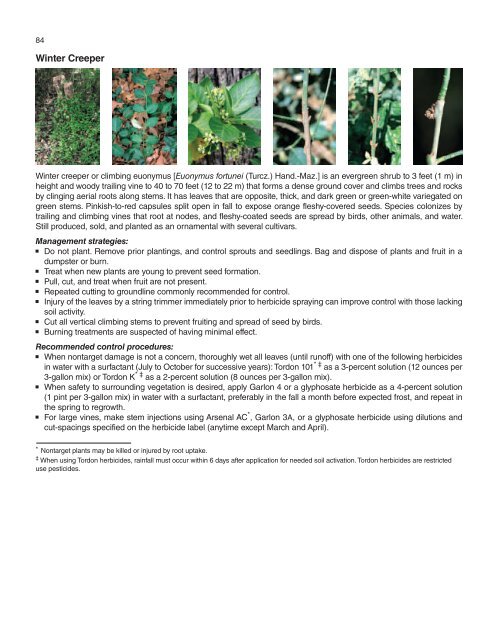A Management Guide for Invasive Plants in Southern Forests James ...
A Management Guide for Invasive Plants in Southern Forests James ...
A Management Guide for Invasive Plants in Southern Forests James ...
- No tags were found...
You also want an ePaper? Increase the reach of your titles
YUMPU automatically turns print PDFs into web optimized ePapers that Google loves.
84W<strong>in</strong>ter CreeperW<strong>in</strong>ter creeper or climb<strong>in</strong>g euonymus [Euonymus <strong>for</strong>tunei (Turcz.) Hand.-Maz.] is an evergreen shrub to 3 feet (1 m) <strong>in</strong>height and woody trail<strong>in</strong>g v<strong>in</strong>e to 40 to 70 feet (12 to 22 m) that <strong>for</strong>ms a dense ground cover and climbs trees and rocksby cl<strong>in</strong>g<strong>in</strong>g aerial roots along stems. It has leaves that are opposite, thick, and dark green or green-white variegated ongreen stems. P<strong>in</strong>kish-to-red capsules split open <strong>in</strong> fall to expose orange fleshy-covered seeds. Species colonizes bytrail<strong>in</strong>g and climb<strong>in</strong>g v<strong>in</strong>es that root at nodes, and fleshy-coated seeds are spread by birds, other animals, and water.Still produced, sold, and planted as an ornamental with several cultivars.<strong>Management</strong> strategies:Do not plant. Remove prior plant<strong>in</strong>gs, and control sprouts and seedl<strong>in</strong>gs. Bag and dispose of plants and fruit <strong>in</strong> adumpster or burn.Treat when new plants are young to prevent seed <strong>for</strong>mation.Pull, cut, and treat when fruit are not present.Repeated cutt<strong>in</strong>g to groundl<strong>in</strong>e commonly recommended <strong>for</strong> control.Injury of the leaves by a str<strong>in</strong>g trimmer immediately prior to herbicide spray<strong>in</strong>g can improve control with those lack<strong>in</strong>gsoil activity.Cut all vertical climb<strong>in</strong>g stems to prevent fruit<strong>in</strong>g and spread of seed by birds.Burn<strong>in</strong>g treatments are suspected of hav<strong>in</strong>g m<strong>in</strong>imal effect.Recommended control procedures:When nontarget damage is not a concern, thoroughly wet all leaves (until runoff) with one of the follow<strong>in</strong>g herbicides<strong>in</strong> water with a surfactant (July to October <strong>for</strong> successive years): Tordon 101 * ‡ as a 3-percent solution (12 ounces per3-gallon mix) or Tordon K * ‡ as a 2-percent solution (8 ounces per 3-gallon mix).When safety to surround<strong>in</strong>g vegetation is desired, apply Garlon 4 or a glyphosate herbicide as a 4-percent solution(1 p<strong>in</strong>t per 3-gallon mix) <strong>in</strong> water with a surfactant, preferably <strong>in</strong> the fall a month be<strong>for</strong>e expected frost, and repeat <strong>in</strong>the spr<strong>in</strong>g to regrowth.For large v<strong>in</strong>es, make stem <strong>in</strong>jections us<strong>in</strong>g Arsenal AC * , Garlon 3A, or a glyphosate herbicide us<strong>in</strong>g dilutions andcut-spac<strong>in</strong>gs specified on the herbicide label (anytime except March and April).* Nontarget plants may be killed or <strong>in</strong>jured by root uptake.‡ When us<strong>in</strong>g Tordon herbicides, ra<strong>in</strong>fall must occur with<strong>in</strong> 6 days after application <strong>for</strong> needed soil activation. Tordon herbicides are restricteduse pesticides.
















